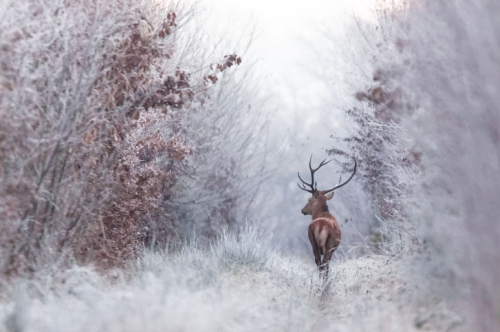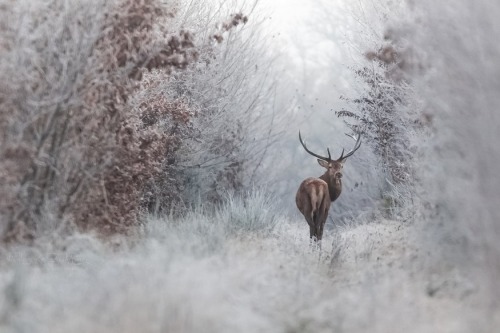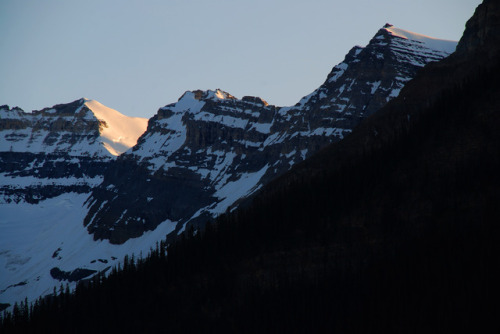This Is What Innocence Looks Like

This is what innocence looks like
Photo by Steve Brooks
More Posts from Spinatlasagne-blog and Others





“Faerie Winter” by Nicolas Le Boulanger

Arctic Fox in Winter
Photo by Jason Paige

This is not an error…
This is what tumblr feed would look like if each country enacted travel ban!! Break down the walls and let people mingle. That’s the only way we would create a greater understanding between cultures, nations and religions and keep America safe. This is not a political statement. As a person who loves to travel and explore cultures I’m appalled at the travel ban. Remember, hatred begets hatred. Reject hate. Tear down this wall of ignorance










Canadian Rockies by Gord McKenna




David Attenborough’s Final Statement for Mankind in The Life of Mammals

Ghost vs. World
Eight Small Satellites Will Give Us a New Look Inside Hurricanes

The same GPS technology that helps people get where they’re going in a car will soon be used in space in an effort to improve hurricane forecasting. The technology is a key capability in a NASA mission called the Cyclone Global Navigation Satellite System (CYGNSS).

The CYGNSS mission, led by the University of Michigan, will use eight micro-satellite observatories to measure wind speeds over Earth’s oceans, increasing the ability of scientists to understand and predict hurricanes. Each microsatellite observatory will make observations based on the signals from four GPS satellites.

The CYGNSS microsatellite observatories will only receive signals broadcast directly to them from GPS satellites already orbiting the Earth and the reflection of the same satellite’s signal reflected from the Earth’s surface. The CYGNSS satellites themselves will not broadcast.

The use of eight microsatellite observatories will decrease the revisit time as compared with current individual weather satellites. The spacecraft will be deployed separately around the planet, with successive satellites passing over the same region every 12 minutes.
This will be the first time that satellites can peer through heavy tropical rainfall into the middle of hurricanes and predict how intense they are before and during landfall.

As the CYGNSS and GPS constellations orbit around the Earth, the interaction of the two systems will result in a new image of wind speed over the entire tropics every few hours, compared to every few days for a single satellite.

Another advantage of CYGNSS is that its orbit is designed to measure only in the tropics…where hurricanes develop and are most often located. The focus on tropical activity means that the instruments will be able to gather much more useful data on weather systems exclusively found in the tropics. This data will ultimately be used to help forecasters and emergency managers make lifesaving decisions.
Launch!

CYGNSS launched at 8:37 a.m. EST on Thursday, Dec. 15, from our Kennedy Space Center in Florida. CYGNSS launched aboard an Orbital ATK Pegasus XL rocket, deployed from Orbital’s “Stargazer” L-1011 carrier aircraft.
Pegasus is a winged, three-stage solid propellant rocket that can launch a satellite into low Earth orbit. How does it work? Great question!

After takeoff, the aircraft (which looks like a commercial airplane..but with some special quirks) flies to about 39,000 feet over the ocean and releases the rocket.

After a five-second free fall in a horizontal position, the Pegasus first stage ignites. The aerodynamic lift, generated by the rocket’s triangle-shaped wing, delivers the payload into orbit in about 10 minutes.
Pegasus is used to deploy small satellites weighing up to 1,000 pounds into low Earth orbit.
And success! The eight CYGNSS satellites were successfully deployed into orbit!
Make sure to follow us on Tumblr for your regular dose of space: http://nasa.tumblr.com

(source)
Astronomy From 45,000 Feet
What is the Stratospheric Observatory for Infrared Astronomy, or SOFIA, up to?

SOFIA, the Stratospheric Observatory for Infrared Astronomy, as our flying telescope is called, is a Boeing 747SP aircraft that carries a 2.5-meter telescope to altitudes as high as 45,000 feet. Researchers use SOFIA to study the solar system and beyond using infrared light. This type of light does not reach the ground, but does reach the altitudes where SOFIA flies.

Recently, we used SOFIA to study water on Venus, hoping to learn more about how that planet lost its oceans. Our researchers used a powerful instrument on SOFIA, called a spectrograph, to detect water in its normal form and “heavy water,” which has an extra neutron. The heavy water takes longer to evaporate and builds up over time. By measuring how much heavy water is on Venus’ surface now, our team will be able to estimate how much water Venus had when the planet formed.

We are also using SOFIA to create a detailed map of the Whirlpool Galaxy by making multiple observations of the galaxy. This map will help us understand how stars form from clouds in that galaxy. In particular, it will help us to know if the spiral arms in the galaxy trigger clouds to collapse into stars, or if the arms just show up where stars have already formed.

We can also use SOFIA to study methane on Mars. The Curiosity rover has detected methane on the surface of Mars. But the total amount of methane on Mars is unknown and evidence so far indicates that its levels change significantly over time and location. We are using SOFIA to search for evidence of this gas by mapping the Red Planet with an instrument specially tuned to sniff out methane.

The plumes, illustrated in the artist’s concept above, were previously seen in images as extensions from the edge of the moon. Next our team will use SOFIA to study Jupiter’s icy moon Europa, searching for evidence of possible water plumes detected by the Hubble Space Telescope. The plumes were previously seen in images as extensions from the edge of the moon. Using SOFIA, we will search for water and determine if the plumes are eruptions of water from the surface. If the plumes are coming from the surface, they may be erupting through cracks in the ice that covers Europa’s oceans. Members of our SOFIA team recently discussed studying Europa on the NASA in Silicon Valley Podcast.

This is the view of Jupiter and its moons taken with SOFIA’s visible light guide camera that is used to position the telescope.
Make sure to follow us on Tumblr for your regular dose of space: http://nasa.tumblr.com
Solar System: Things to Know This Week
Celebrate with us as our Opportunity rover turns 13, view art from our fans and more!
1. All Grown Up
After exceeding her 90-day mission and design parameters many times over, our plucky little rover Opportunity turns 13 years old on the Red Planet. She’s officially a teenager!
2. People’s Space

The public contributes so much wonderful art that we decided to make a place to share it. Enjoy!
3. Ready for a Close Up

Our Juno spacecraft recently got a closer look at Jupiter’s Little Red Spot. The craft’s JunoCam imager snapped this shot of Jupiter’s northern latitudes on December 2016, as the spacecraft performed a close flyby of the gas giant. The spacecraft was at an altitude of 10,300 miles above Jupiter’s cloud tops.
4. A New Test for Life on Other Planets

A simple chemistry method could vastly enhance how scientists search for signs of life on other planets. The test uses a liquid-based technique known as capillary electrophoresis to separate a mixture of organic molecules into its components. It was designed specifically to analyze for amino acids, the structural building blocks of all life on Earth.
5. Blurring the Line Between Asteroid and Comet

Our NEOWISE mission recently discovered some celestial objects traveling through our neighborhood, including one on the blurry line between asteroid and comet. An object called 2016 WF9 was detected by the NEOWISE project in November 2016 and it’s in an orbit that takes it on a scenic tour of our solar system. A different object, discovered by NEOWISE a month earlier, is more clearly a comet, releasing dust as it nears the sun.
Discover the full list of 10 things to know about our solar system this week HERE.
Make sure to follow us on Tumblr for your regular dose of space: http://nasa.tumblr.com
-
 intheshadowsbby reblogged this · 2 years ago
intheshadowsbby reblogged this · 2 years ago -
 problematic-rayndrop liked this · 4 years ago
problematic-rayndrop liked this · 4 years ago -
 stupidstuffpeoplesay liked this · 4 years ago
stupidstuffpeoplesay liked this · 4 years ago -
 imagerynation reblogged this · 4 years ago
imagerynation reblogged this · 4 years ago -
 violently-nerdy liked this · 5 years ago
violently-nerdy liked this · 5 years ago -
 anthro-cat liked this · 5 years ago
anthro-cat liked this · 5 years ago -
 lunarlux9 liked this · 6 years ago
lunarlux9 liked this · 6 years ago -
 don-omar-78 liked this · 6 years ago
don-omar-78 liked this · 6 years ago -
 derpymuffinhooves liked this · 6 years ago
derpymuffinhooves liked this · 6 years ago -
 derpymuffinhooves reblogged this · 6 years ago
derpymuffinhooves reblogged this · 6 years ago -
 emmasuwus liked this · 6 years ago
emmasuwus liked this · 6 years ago -
 warriors-synpaths liked this · 6 years ago
warriors-synpaths liked this · 6 years ago -
 zsebi1220 reblogged this · 6 years ago
zsebi1220 reblogged this · 6 years ago -
 zsebi1220 liked this · 6 years ago
zsebi1220 liked this · 6 years ago -
 itsvictorianroses7artpage-blog liked this · 7 years ago
itsvictorianroses7artpage-blog liked this · 7 years ago -
 ken105xd liked this · 7 years ago
ken105xd liked this · 7 years ago -
 littlecherokee-55 reblogged this · 7 years ago
littlecherokee-55 reblogged this · 7 years ago -
 love-it-all-55 liked this · 7 years ago
love-it-all-55 liked this · 7 years ago -
 victorianroses7 liked this · 7 years ago
victorianroses7 liked this · 7 years ago -
 fiocainthesky liked this · 7 years ago
fiocainthesky liked this · 7 years ago -
 hammytotherescue liked this · 7 years ago
hammytotherescue liked this · 7 years ago -
 bikers-in-leathers-are-hot liked this · 7 years ago
bikers-in-leathers-are-hot liked this · 7 years ago -
 spacefoxy-irl reblogged this · 7 years ago
spacefoxy-irl reblogged this · 7 years ago -
 spacefoxy liked this · 7 years ago
spacefoxy liked this · 7 years ago -
 gltzgghln reblogged this · 7 years ago
gltzgghln reblogged this · 7 years ago -
 eating-lead-paint liked this · 7 years ago
eating-lead-paint liked this · 7 years ago -
 cherrypersephone liked this · 7 years ago
cherrypersephone liked this · 7 years ago -
 ritalinnrat reblogged this · 7 years ago
ritalinnrat reblogged this · 7 years ago -
 flufflepuff-the-hufflepuff liked this · 7 years ago
flufflepuff-the-hufflepuff liked this · 7 years ago -
 ajdjwjfjekskw reblogged this · 7 years ago
ajdjwjfjekskw reblogged this · 7 years ago -
 ajdjwjfjekskw liked this · 7 years ago
ajdjwjfjekskw liked this · 7 years ago -
 lost-trough-madness reblogged this · 7 years ago
lost-trough-madness reblogged this · 7 years ago -
 lost-trough-madness liked this · 7 years ago
lost-trough-madness liked this · 7 years ago -
 nozomi-minaj liked this · 7 years ago
nozomi-minaj liked this · 7 years ago -
 beatrixinwonderland liked this · 7 years ago
beatrixinwonderland liked this · 7 years ago -
 nordhilt liked this · 7 years ago
nordhilt liked this · 7 years ago -
 gothicvalentine liked this · 7 years ago
gothicvalentine liked this · 7 years ago -
 ariesmassiel12 liked this · 7 years ago
ariesmassiel12 liked this · 7 years ago -
 himuansirrurth-blog liked this · 7 years ago
himuansirrurth-blog liked this · 7 years ago -
 diepjun liked this · 8 years ago
diepjun liked this · 8 years ago -
 wolf-of-avalon reblogged this · 8 years ago
wolf-of-avalon reblogged this · 8 years ago -
 wolf-of-avalon liked this · 8 years ago
wolf-of-avalon liked this · 8 years ago